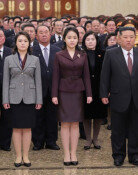U.S. Options in Taiwan War Scenarios
U.S. Options in Taiwan War Scenarios
Posted September. 01, 2006 07:01,
Four scenarios for China-U.S. conflict:
Scenario A-
A low-intensity conflict scenario in which Chinas special warfare forces invade into Taiwan. The special forces, whose number is unaccounted for, albeit some estimates at around 100 to 1,000, sneak into Taiwan in small boats, submarines and helicopters with the aid of its military intelligence group acting secretly in the island. The targets of the forces are not just Taiwanese politicians and military leadership but also power plants, traffic hubs, early warning system and command & control facilities. The Chinese aim at fostering fear and anxiety among the Taiwanese by destroying the base of the Taiwanese government. This invasion might pave the way for a following massive attack by the Chinese armed forces.
Scenario B-
A scenario that assumes an accidental clash between China and Japan. China stations its submarines, destroyers and other war vessels in the disputed area of the Senkaku or Diaoyutai islands in the East China Sea under the name of protection of natural gas drilling work areas. For its part, Japan immediately sends its P-3 patrol planes, Ageis ships, and F-15 fighters there. At night, Chinese submarines and Japanese destroyers clash to wreak a great havoc on both sides. Japanese forces approach badly damaged Chinese submarines to rescue. China sees it a hostile act, firing two anti-ship missiles. But Japans Aegis cruisers succeed in intercepting them. Both countries navies confront each other. Finally, submarines sink, prompting both countries to prepare dispatching reinforcements. The Japanese ambassador to Washington asks for a meeting with the U.S. President.
Scenario C-
A worst-case scenario in which China invades Taiwan in an all-out manner, deploying its full military: army, air force and navy. The Chinese military wants to carry out a swift attack in order to deter military intervention from third countries including the U.S.
Scenario D-
A scenario that supposes a preemptive attack by Taiwan on China. As China conducts a joint operation of army, navy and air forces, Taipei regards the exercise as an imminent attack by Beijing and orders its forces to attack Chinese forces in the Taiwan Strait. Also Taiwan opens air bombing and missile attacks on southern Chinas ports, airports and missile bases while pounding ships in the Chinas territorial sea. Taiwans special forces take a great toll on Chinas submarines.
How will the U.S. respond?-
All four scenarios suppose a situation in which the U.S. will be unavoidably involved in the regional conflict. That is because the U.S. is in a military alliance with Japan based on the 1951 U.S.-Japan Mutual Security Treaty, while it has also signed onto the Taiwan Relations Act in 1979 to pledge to defend Taiwan in case of war.
However, due to geographical distance, the U.S. finds it difficult to respond quickly to the potential conflict and its military is stretched thin due to Iraq. It cannot predict the consequences of using nukes or putting excessive military in the conflict in a hurry.
Therefore, the report settles for predicting the U.S. response to the conflict by classifying it in four stages: deterrence, crisis stability, war fighting and war termination and analyzing, and pros and cons for each stage.
Response to each scenario-
The report picks scenario B as the one the U.S. is best prepared to respond to. In the early stage of a conflict, as the report goes, the U.S. will delay its military intervention so as to give diplomacy enough time. But once it steps in, the report sees that the U.S. will handily outrun Chinese forces. Yet, the bottom line is to block a crisis from spreading into an all-out war.
Scenario C is the worst one and possibly a nuclear war. The U.S. is thought to be able to target China with its nuclear weapons to end the conflict quickly. But the report cautions the ensuing political repercussions after a nuclear war. And it also points out that the U.S. might have to risk a long-term dispatch of its forces in Taiwan in case of a conventional war.
The low-intensity scenario A appears to be a tricky one for the U.S. in that it will have difficulty in stepping in itself. The U.S is expected to be handy in intelligence in the early days, but once after intervention, it would be difficult for the U.S to secure a quick victory plus having to risk street warfare like in Iraq.
Equally tricky to respond to is scenario D. Once a war breaks out between the Taiwan Strait, unless it ends with one-sides victory, nobody will surrender. While U.S. putting responding forces swiftly in a massive scale might guarantee winning for Taiwan, it will take it a tremendous cost of long-time dispatch of its forces and post-war situation will remain very unstable, says the report.
klimt@donga.com





![“나 도시락이야”…경찰도 못 연 문이 열렸다 [따만사]](https://dimg.donga.com/c/138/175/90/1/wps/NEWS/IMAGE/2026/01/01/133077778.1.jpg)

